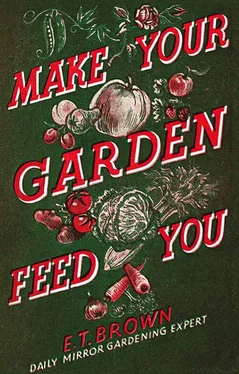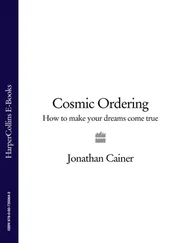The only thing that need be said regarding the application of water is that sprinkling the ground is worse than useless; give it a good soaking, for this alone benefits the crops. A sprinkling tends to cause the roots of the plants to come upwards so that they can make use of the moisture and, being close to the surface, they may easily be burned when the sun is shining brightly. Water occasionally and water liberally is the best advice that can be given.
Manuring, or the provision of plant food, is an absolute necessity in gardening. Without it good results over a period of years are impossible. Farmyard manure, or an efficient substitute, must be incorporated with the soil. These natural substances not only feed the plants but, as they decay, they increase the store of humus (decayed organic material) and humus is the very essence of fertility. It binds the soil together, but at the same time it leaves it porous so that air is freely admitted and water can percolate through it; it warms the soil and it helps it to retain moisture. Farmyard manure (stable, cow, and pig) also contains millions and billions of bacteria, and these play a highly important part by their action of liberating plant food.
When natural manures are available they should be applied at the rate of one barrowload to every ten square yards. Stable manure is better for heavy land, and cow and pig manures for light.
While it is true that horses are being used more at the present time, owing to petrol rationing, the majority of gardeners will find it extremely difficult to obtain supplies of horse manure. The ordinary gardener is faced with a difficulty in this connection, because it means running the place with very little or no natural manure. Humus must, however, be provided, or sooner or later the soil will show definite signs of weakness and the crops will consequently suffer.
TO USE MANURE FROM POULTRY AND RABBITS
Natural manures may not be obtainable, but all vegetable matter is capable of supplying humus, so the war-time gardener must take stock of what is available in his own district. But before dealing with the numerous substitutes which can be used successfully something may be said about the two manures which are produced by poultry and rabbits.
Poultry manure is first-class. When fowls are kept on the intensive system in a scratching-shed the droppings are available in two forms. There are the neat droppings (or mixed with a little dry earth or sand) from the droppings-board placed beneath the perches; there is also the manure-impregnated litter from the poultry-house floor. The latter is invaluable for digging into the soil in the autumn or winter when the vegetable plots are being treated to their annual digging, a useful dressing being 1 cwt. to one-sixth of an acre. The straw or dried leaves used as litter supply humus; the droppings supply other plant foods, nitrogen, potash and phosphorus. But since poultry manure is rather deficient in the last-mentioned, it is advisable to add a fifth part by weight of mineral superphosphates to the litter manure.
The neat droppings are best used for top-dressing; that is, applying to the crops as they are actually growing, in the same way as chemical fertilisers are employed. A satisfactory dressing is 1/ 2oz. per yard of row.
Rabbit manure is not very rich in plant food, but it is very durable and so supplies nourishment for many months on end. It should be dug into the soil in the autumn or winter at the rate of 28 lb. per rod. It will be necessary to collect this manure for a whole year as it is only applied at digging time in the autumn or winter. To store it, cover with vegetable refuse or mix with the compost heap.
TO OBTAIN AND STORE LEAF-MOULD AND COMPOST
Every opportunity should be taken in the late summer and autumn of collecting fallen leaves. These, when properly rotted down, become what is known as leaf-mould, which is first-class for many different purposes. The leaves as they are collected should be heaped up on a site reserved for them and covered with wire-netting to prevent them being blown all over the place. They should be allowed to remain for ten to twelve months. There is just one point in connection with the making of leaf-mould. Oak and beech leaves should not be added to the heap. They should be reserved for making the hot-bed in the sunk pit, if one is made, or failing this they should not be gathered.
Right throughout the year there is a supply of waste or refuse vegetable stuff; material which is not good enough for the house and not even suitable for the fowls and rabbits. Although unfit for consumption it should certainly not be thrown away, since most of it can be converted into valuable plant food and humus provider with little trouble.
When the various plots are being cleared it will be found that there are two different kinds of refuse. Some of it, like cabbage stumps, does not rot down, but much is soft and succulent and decays rapidly. The former should be consigned to the bonfire—the resulting ashes are extremely useful—but the latter should be stacked. There are two ways of doing this. A heap can be formed on the ground surface, or a hole can be dug and the soft material thrown therein. A 6 ft. by 5 ft. area provides a suitable place, and it is suggested that as there is usually a considerable quantity of refuse to deal with, a pit should be dug.
As the refuse is gathered—surface-rooting weeds, turnip and carrot-tops and the like—it should be deposited in the pit, and now and again a few shovelsful of soil should be scattered on top. In the ordinary garden it is possible to improve the compost greatly by throwing on all the household “ slops,” including soapy water, but this is not a practical suggestion when the allotment is some distance from the house. To obviate any unpleasant odour a little lime may be scattered over the refuse occasionally.
SUBSTITUTES FOR FARMYARD MANURE
One of the best substitutes for farmyard manure is hop manure. There are numerous proprietary manures of this description; all have spent hops as the basis (these supply humus) together with various chemicals. They are excellent, while they are easy and clean to handle and apply. They should be used at the rate advised by the vendors.
Many different kinds of organic refuse are converted into manure. They include shoddy, leather dust, damaged cattle cakes, rape dust, cotton-seed dust, feather waste, hair waste, hoof and horn waste, and so on. The amateur gardener should make inquiries in his own district concerning whether any of these are obtainable. If so they should be applied and dug into the soil in the autumn or winter in the same way as natural manure and at the same rate—three barrowloads to the rod.
Those who live near a large town or in a city may be able to obtain regular supplies of sewage. The solid matter is extracted and usually mixed with lime, alumina, and other chemicals and disposed of to agriculturists. It is usually obtainable in two forms—sludge which is something like soft clay, or dried and ground into a fine powder. The former is the better. It should be applied at the rate of 4 cwt. to the rod and dug in during the winter, preferably after it has lain on the surface for a short time and been subjected to a few frosts.
Gardeners living at the seaside may be able to collect seaweed. This is excellent and about equal in value to farmyard manure. It should be stacked up and allowed to rot down. Apply and dig into the soil in the autumn or winter.
Green manuring is a highly satisfactory way of increasing the fertility of the soil and increasing its humus content. It can, however, be practised to only a limited extent in the garden or on the allotment, since it implies leaving the ground vacant for eight to ten weeks. If you are making a new allotment, however, where the ground is not particularly rich and planting or sowing is not to be carried out for a while, green manuring is recommended.
Читать дальше












